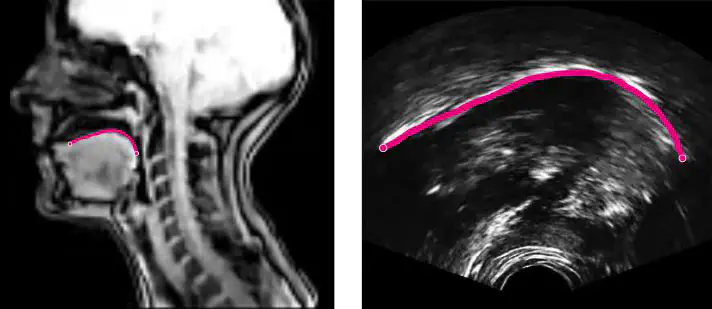The articulation of dark /l/ by L2 speakers of English: Insights from Magnetic Resonance Imaging and Ultrasound Tongue Imaging

Abstract
Over the past 15 years, High Temporal Resolution Magnetic Resonance Imaging (HTR-MRI) has emerged as the optimal visualization technique in speech production (Isaieva et al. 2021; Lim et al. 2021). Compared to Ultrasound Tongue Imaging (UTI), HTR-MRI has the advantage of imaging all linguistically relevant structures (lips, tongue tip, soft and hard palate, uvula, pharynx, and larynx). However, there are few publicly available databases, none of which focuses on bilingualism. As part of pilot studies to develop an HTR-MRI database of French learners of English, this presentation will examine the production of the dark allophone of /l/ by three advanced L2 English speakers and a native speaker of English. French /l/ is consistently produced as a clear [l] with a single apico-alveolar constriction, whereas dark [ɫ] occurs in many standard varieties of English in syllable codas and is realized with a retraction of the back of the tongue followed by an apico-alveolar gesture (Sproat and Fujimura 1993). We investigate whether L1 French speakers display native-like speech gestures in their L2; meaning whether they develop a distinct double articulation for English dark /l/. The linguistic material consisted of three repetitions of two lists of 30 words in French and English, with /l/ in initial and final positions in various vowel contexts. MRI data consisting of mid-sagittal images of the vocal tract were acquired on a 3T MR scanner (Vantage Galan 3T XGO; Canon Medical Systems, Tochigi, Japan) at a rate of 10 fps. All participants exhibited a dark /l/ in English, with two constrictions in coda position: at the tongue dorsum and tip (Fig.1, 5-8). Native and non-native speakers of British English produced a clear onset /l/ in French and English, with a single alveolar constriction at the tongue tip (1, 2, 4). However, the American English L2 speaker velarised /l/ in that position (3), aligning with darker onset productions observed in native speakers of that variety (Recasens 2012). Interestingly, the distinct “saddle” shape of dark /l/ (Wrench and Scobbie 2003) was visually less prominent in one L2 English speaker who displayed an atypical constriction at the pharynx rather than the velum (6), suggesting an alternative articulatory strategy for achieving darkness. These observations will be further discussed in the final presentation, supplemented by data collected with UTI using the same protocol.
References
Isaieva, Karyna, Yves Laprie, Justine Leclère, Ioannis K. Douros, Jacques Felblinger, and Pierre-André Vuissoz (Oct. 2021). “Multimodal Dataset of Real-Time 2D and Static 3D MRI of Healthy French Speakers”. In: Scientific Data 8.1, p. 258. DOI: 10.1038/s41597-021-01041-3.
Lim, Yongwan et al. (July 2021). “A Multispeaker Dataset of Raw and Reconstructed Speech Production Real-Time MRI Video and 3D Volumetric Images”. In: Scientific Data 8.1, p. 187. DOI: 10.1038/s41597-021-00976-x.
Recasens, Daniel (2012). “A Cross-Language Acoustic Study of Initial and Final Allophones of /l/”. In: Speech Communication 54.3, pp. 368–383. DOI:10.1016/j.specom.2011.10.001.
Sproat, Richard and Osamu Fujimura (July 1993). “Allophonic Variation in English /l/ and Its Implications for Phonetic Implementation”. In: Journal of Phonetics 21.3, pp. 291–311. DOI: 10.1016/S0095-4470(19)31340-3.
Wrench, Alan A and James M Scobbie (2003). “Categorising Vocalisation of English /l/ using EPG, EMA and Ultrasound.” In: Proceedings of the 6th International Seminar on Speech Production.